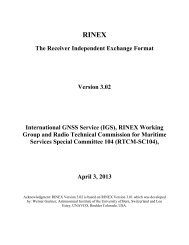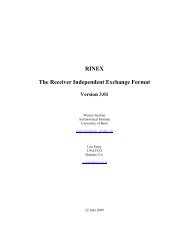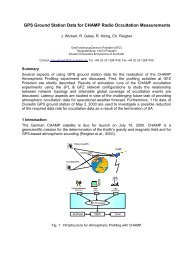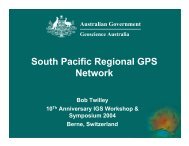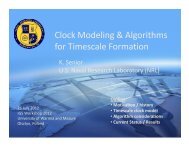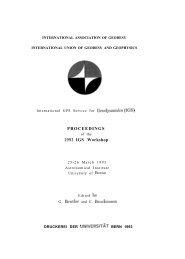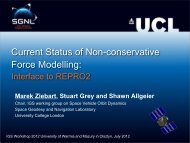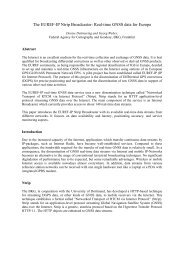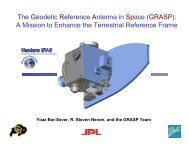applied to the solution in order to avoid possible numerical problems associated with a 3-rank deficiency.s It is also important to keep the free network within a few meters ofconvention (ITRF) so that linear transformations can still be applied to the networksolution. The rank deficiency is removed only after all solutions are combined into one,otherwise we would be faced with the difficult situation where solutions submitted bydifferent agencies have different a priori constraints. For the routine production of orbitsand EOP parameters, global analysis centers can save a lot of processing time if they firstproduce the loosely constrained solution to extract the “fiducial-free” network and EOPestimates; then fix a subset of stations to recommended coordinates, and extract the orbitsand EOP in the standard frame.Loose Constraints.G Loose constraints are applied in the form of a nominal value with an apriori standard deviation. “Loose” is defined such that the observable quantities that wecare about (e.g., baseline lengths) are negligibly affected by the constraint. This raises twoissues: (i) How good should the nominal values be? (ii) How “loose” should the a prioristandard deviations be? In answer to the first question, only loosely constrain those stationcoordinates that are known to at least an order of magnitude better than the applied a prioristandard deviation. In answer to the second question, what is relevant is the ratio of a priorivariance to the variance computed in the absence of constraints. We note that the locationof the network with respect to the geocenter (a net translation) can be particularly sensitiveto indiscriminate application of a priori constraints, so we place a note of caution here. Forexample, if an a priori constraint of 10 cm is applied to all coordinates of a 25 stationnetwork, this effectively constrains the net translation to 10/~= 2 cm, which may becomparable to the formal standard deviation computed using the data alone (with no a prioriconstraints), thus significantly biasing the solution towards the nominal geocenter. Wetherefore simply recommend that (i) at least 3 stations (but e 100) be loosely constrainedwith a 10 meter a priori standard deviation, and that constraints should only be applied tostations whose nominal values are consistent with ITRF to better than a meter..Re~ional Anal@. For regional network estimation where station coordinates are allestimated, the scale, orientation, and origin are defined by fixing the supplied orbits andpolar motion. However, the network is not well tied to the origin for regional sizednetworks since a net translation is strongly correlated with the satellite clock parameters.’One way to deal with this problem is to use the globally determined clock parameters, andnot estimate the satellite clocks. However, this method is not likely to ever be as precise asincluding a station whose position is routinely estimated in global analyses (a “common”station). In addition, we recommend at least 3 common stations so that network orientationand scale can be monitored and corrected, and so that network distortions caused byremaining orbit errors can be corrected to first order.g In practice, a regional center canimmediately produce a solution for it’s own purposes by constraining the coordinates of the3 common stations to the ITRF. From the <strong>IGS</strong> point of view, it is important to receive thefiducial-free regional solutions because the common station coordinates themselvesimprove in time as more global solutions accumulate, and it is important to properlypropagate those changes into the regional solutions. It is also important that the <strong>IGS</strong>5A 1-rank deficiency is ~au~ by ~~~~t ~orr~]~tio~ betw~n s~tion longitude and the ascending node Of thesatellite orbits, and an additional 2-rank deficiency is caused by a perfect correlation between the X and Ypole parameters and a global rotation of station coordinates about the X and Y axes.6Actually, no-constraints should be applied if solutions are represented by normal equations or SRIFmatrices, as will be discussed in section 3.3.7An equivalent point of view is that in the limit of short baselines, the direction to the satellites is thesame for both stations, hence both stations can move together without significantly affecting singledifferencedobservations from the same satellite.8 9common station coordinates give 3 origin parameters+ 1 scale + 3 orientation angles + 2-dim. strain.73
eceive the freely estimated locations of the 3 common stations, since they provide a tool toprobe systematic orbit errors as they affect different geographical regions, Ourrecommendation to regional analysis centers is the same as for global analysis centers: the 3(or more) common stations should be constrained with an a priori standard deviation of 10meters, but the nominal values should be consistent with the ITRF at the level of 1 meter orb e t t e r ,3.2 Combination of regional and global coordinate solutionsWe have already outlined the fiducial-free approach and why it is important for thecombination of regional and global coordinate solutions. The implicit assumption is thatregional networks will add very little additional information to the determination of orbits orEOP. We should also note that it would be undesirable to adjust further the globallydetermined “common station coordinates” based on regional network solutions, because thesame data would be used twice. Therefore, in combining regional with global solutions,we recommend that the global estimates for the common stations and their covariancematrix elements remain unperturbed by the regional solution, and that the solution be onlyaugmented by those regional stations that are not common stations. Before augmentation,however, the common station estimates in the regional solution should be combined withthe global solution in order to ensure reference frame consistency. Many of the details ofthe combination should probably be left to the NAC’S to develop, since it is not an entirelytheoretical question and techniques will undoubtedly evolve as NAC’s gain moreexperience with real data, Some of the issues that need to be addressed include relativeweighting schemes, treatment of outliers or problematic solutions, minimal constraints,treatment of network distortion of common stations in regional solutions, etc. Morecomplicated schemes will be able to derive, by backsubstitution, transformations, etc., acomplete time-series of both global and regional station coordinates, and polar motion in aconsistent reference frame.What we do need to decide on is a parameterization and a format to submit fiducial-freesolutions. This is a difficult problem due to differences in software packages.3.3 Parameterization of submitted solutionsParameterization should be flexible given that different software packages work infundamentally different ways. Both the file name and file header will indicate what type ofparameterization is used. The file name is important since it is useful for scripts to handle.The file header is important as a consistency check for the reading program.(i) We should consider allowing both Cartesian (X, Y, Z) and spherical coordinates(spherical latitude, longitude, and radius). An alternative to this is to allow only Cartesiancoordinates (as recommended by IERS), which would mean that centers such as GFZ whouse spherical parameters would have to reformat their solutions. GFZ argues that sphericalparameters have the advantage that they are more natural for imposing certain a prioriconstraints (e.g., orientation). Cartesian parameters have the advantage that they havehomogeneous units, and are more natural for imposing certain a priori constraints (e.g.,translation).(ii) We shoyld consider allowing three types of solution representation.(a) The most basic representation has the parameter estimates x, and the variancecovariancematrix M = (A ~CA)- 1. The covariance matrix is more compactly written asthe correlation matrix (because elements are from -1 to +1), augmented with the..74
- Page 1 and 2:
●INTERNATIONAL ASSOCIATION OF GEO
- Page 3 and 4:
TABLE OF CONTENTS.FINAL AGENDA . .
- Page 5 and 6:
13:30 NGS14:00 S1014:30 EMR15:00 CO
- Page 7 and 8:
LIST OF PARTICIPANTS:Prof. Gerhard
- Page 10 and 11:
Table 1. Current IGS Analysis Cente
- Page 12 and 13:
The first field identifies the reco
- Page 14 and 15:
Summary InformationThe third produc
- Page 16 and 17:
From Figure 1 we find that there ar
- Page 18:
to define a reference clock in thei
- Page 22 and 23:
SESSION 2(IGS orbit products)
- Page 24 and 25:
1. introductionThe main objectives
- Page 26 and 27: ecause of the above averaging. This
- Page 28 and 29: RMS per center (m)o 0 0 0 0 0 oA0Iv
- Page 30: Scale (ppb)I I I I I 11+-b~ul0Amo&I
- Page 33 and 34: and NGS. Note that the day to day v
- Page 35 and 36: Rotation around X-axis (mas)1&0 0o
- Page 37 and 38: discussed in Section 3 are here see
- Page 39 and 40: -----------------------------------
- Page 41 and 42: Residuals in Meters1 1 1 1 1 1 1=%m
- Page 43 and 44: Residuals inMeters11111cnficJJw-o A
- Page 45 and 46: I I I—Residuals in Meters..—.
- Page 47 and 48: 1111ResidualsMeters,—{44
- Page 49 and 50: Residuals in MetersI I I II I I IIc
- Page 51 and 52: Rms in MetersI 1 ! I 1 10 n0 a0n.ff
- Page 53 and 54: IGS- and the COM-sets, but that the
- Page 55 and 56: Table 4.1 N.A. Baseline Repeatabili
- Page 57 and 58: ..Figure 5.1:Clock solutions for FA
- Page 59 and 60: specifically the preanalysis can be
- Page 61 and 62: discussion, a question as to whethe
- Page 63 and 64: SUMMARY OF SESSION 3This Session be
- Page 65 and 66: IGS POSITION PAPER, IGS ANALYSIS CE
- Page 67 and 68: and Earth orientation parameters (E
- Page 69 and 70: LbPIERS and IGSCentral Bureausand D
- Page 71 and 72: @ IGS will develop instructions, an
- Page 73: 2.2 Analysis Center System DesignFi
- Page 78 and 79: ..standard deviations. This is conv
- Page 80 and 81: known, the two solutions will be ad
- Page 82 and 83: errors, and can therefore be used a
- Page 84 and 85: International Terrestrial Reference
- Page 86 and 87: Thus, there is the potential of fee
- Page 88 and 89: 90” 100” 110” 120” 130” 1
- Page 91 and 92: adiation parameters for each satell
- Page 93 and 94: Bock, Y., R.I. Abbot, C.C. Counselm
- Page 95 and 96: SUMMARY OF SESSION 4This session st
- Page 97 and 98: INTERNATIONAL EARTH ROTATION SERVIC
- Page 99 and 100: x- differences with IERS0.001”I I
- Page 101 and 102: SUMMARY OF SESSION 5In the last ses
- Page 103 and 104: 1) I(X3 PROCESSING/REPORTS/FORMATSS
- Page 105 and 106: IGS should foster and encourage reg
- Page 107 and 108: ..INTERNATIONAL GPS SERVICE FORGEOD
- Page 109 and 110: ortL.s.4
- Page 111 and 112: 1234567a91011121314IsIt17ItIs2C2122
- Page 113 and 114: . Ruth Neilan16S Central BureauJet
- Page 115 and 116: ON1T.>● Jim ZumbergeJet Propulsio
- Page 117: PROPOSED ORGANIZATION OF THE INTERN




